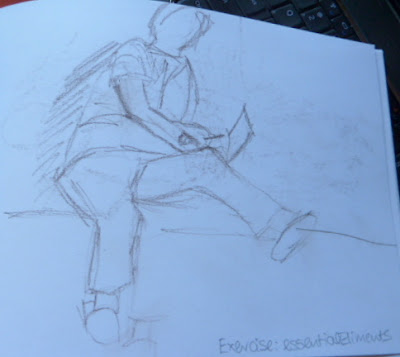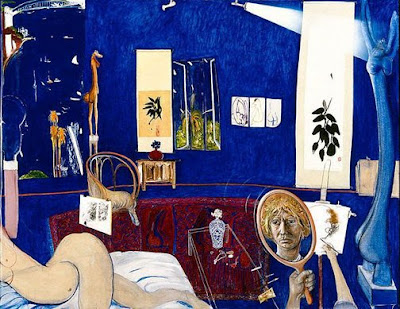Exercise: Quick Poses
Unfortunately at this time I did not have a live model so I sketched from a photograph that I took.
I was a bit surprised that I had the correct proportions of the body when I did a scale of the seven sections.
A 10 minute pose using charcoal and then a combination of graphite and pencil which I consider to be the best combination for this drawing. The head is a bit like a space alien...
I found this elderly man sitting on a wall near the sea.
The second drawing I did from the photograph captured the moment I think.
Exercise: The Longer Pose
Check and Log
Q: Have you managed to make a complete statement in this time? What were your main problems?
A: Yes I think so I was able to draw the life model in the same place for 20 minutes, a miracle. I like the drawing especially where the leg crosses the other. The main problem when looking at this photograph of the drawing is that perhaps the bench could have been more accurate.
Q: How well have you captured the characteristics of the pose?
A: I think its a reasonable beginning to this assignment.
Q: Do the proportions look right? If not, how will you try to improve this?
A: The proportions look correct but I am still not happy with the head shape. I will try to look more carefully at the shape of the head.
PROJECT: Form
Exercise: The Essential Shapes
I drew this one of my photographs but I think that I captured the movement and direction of the body reasonably well.
Exercise: The Essential Elements
My life model although very willing was so stiff and rigid, it was difficult to get him to relax...
Check and Log:
Q: Were you able to maintain a focus on proportion at the same time as creating a sense of weight and three-dimensional form?
A: I found that the more I did the better I was able to create a sense of weight and form, well at least I think I did.
Q: Which drawing gives the best sense of the pose and why?
A:I like the first pose of the subject sitting on the bed with the computor, I think the likeness of the pose was very good, but the size of the head or perhaps the location of the eyes etc is not correct.
Q: Was there any movement or gesture away from the model's central axis, If so did you manage to identify this and put it into your drawing?
A: In the essential shapes drawing of an 11 year old boy I think I was able to draw the movement in the spine and the different angle that he was sitting while he was studying what was in his hands.
PROJECT:Gesture
Exercise: Stance

Exercise: Energy
Check and Log:
Q: How well have you managed to capture the poses? What could be improved?
A: I think I have managed to capture the poses using simple lines without too much detail. With more practice I am sure I will improve.
Q:Do you think that your figures balanced. If not where did you go wrong?
A: I think the first couple of poses the figures were very balanced but then the last one I did not seem to get the lines of the man standing correct so it kind of unbalanced the whole drawing.
Q: How did you go about conveying a sense of energy?
A:I tried to convey the sense of energy by accurately drawing the lines of the bodies in relation to each other. I like the energy of the second drawing very much.
PROJECT: Structure
Research Point: I particularly enjoy reading my book ''Drawing Lessons from the Great Masters''. The author Robert Beverly Hale states that we must 'cultivate the habit of forcing everything we see into its simplest geometric form'. Excellent advice when looking at the body in order to make an accurate drawing. I try to be aware of the skeleton of the body when drawing the body.
This drawing 'Standing Figure of a Nude Woman' in red chalk by Annibale Carraccii (1560-1609) is an excellent example of using spheres, egg shapes, cylinders to create a believable drawing.
This drawing by Luca Cambiaso (1527-1585) 'Christ Leading the Calvary' in pen and bistre show the different planes of the body which greatly assists the accuracy of a drawing of the body. You do need, however, a good solid knowledge of the skeleton and muscles of the body to know where the planes of the body are in order to draw a believable piece of work. I am also very impressed by the drawings of Leonardo da Vinci (1452-1519) I think his works of the human body are truly inspirational.
Exercise: Three Drawings
Check and Log:
Q: How accurately did you depict the overall proportions of the figure?
A: I think that I was quite accurate but I am sure with more practice I would improve.
Q: Did you try to imagine the sitters's skeleton and muscles? Did this help you to convey the figure's structure and form?
A: Yes I did consider the skeleton and muscles of the sitter and I think its greatly assisted my interpretation of the drawings.
I prefer the drawing of the model sitting down and I think that I captured the relaxed state but perhaps that is because I used charcoal and its easier to see online than the pencil drawings. I struggled a little with the knees and legs of the 'laying down' pose.
PROJECT: The Clothed Figure
Exercise: Form and movement in a clothed figure
I had to find a clothed figure on the internet as I had no model. I liked the way the sarong sat around the models round figure.
Q: Did you find it easy to approach the figure as a whole or were you distracted by details of the sitter's dress?
A:I found it quite easy approach the figure as a whole and enjoyed drawing.
Q: How did you create volume in the folds of the fabric?
A: Using cross hatching lines.
Q: Does the finished drawing give a sense of the figure beneath the fabric?
A:Yes, I think so, the figures is very rounded.
Q: How would you tackle a drawing like this again?
A: Probably using the same methods I used for this drawing.
PROJECT: The Moving Figure
Exercise: Sitting and Waiting
I did several sketches of these people sitting on a park bench which I enjoyed. They were far enough away not to notice my interest in them.
Exercise: Fleeting Moments
This area was probably my favorite as its great to put down a few lines and you can see the the story of what you are drawing.
Check and Log:
Q: How well did you manage to create the sense of a fleeting moment rather than a pose?
A: I think I did really well. I drew very fast without really thinking and found it was much better than considering every pencil line. For me it was much more enjoyable.
Q: How successful were your attempts to retain an image and draw later?
A: I took photographs so it was easy. I always try to take photographs of things I would like to draw.
Q: Were you able to keep to a few descriptive lines to suggest the person's movement or were you tempted to keep introducing more elements into your work?
A: I was able to keep to a few descriptive lines and thats what I think was so exciting about drawing like this. Obviously this takes care and observation to get it right but I prefer this kind of drawing.
PROJECT: Self Portrait
Exercise: Drawing your face
I am not so sure, but I don't think this looks like me at all, perhaps its what I think I look like, a mystery for sure.
Research Point:
I very much enjoy the works of Matisse and was fortunate to see his exhibition in Brisbane Australia in February this year. His drawings are very simplistic and beautiful. At the exhibition they had set up a big room re-creating scenes from his drawings with big sofas, huge bowls of fruit and beautiful chairs. Live models were also available to draw. Many artists stood around drawing in the style of Matisse. It was a great expirience.
This is a self portrait of Henri Matisse in 1906. I like his use of green on his face.
Picasso is another artist whose self portraits are very interesting. The first self portrait done in 1901 shows a face that is very precise and well drawn in my opionon. The second a more abstract interpretation produced 6 years later in 1907.
This is one of a series of final self portraits of Pablo Picasso which he called 'Facing Death' in 1972. His fear is shown I think in this painting of perhaps dying. It is estimated that he did more than 50,000 works of art in his lifetime.
I really enjoy this self portrait by Brett Whitely 'Self Portrait in the Studio'. 1975, a well known Australian artist who sadly died in 1992.
Check and Log:
Q: Which drawing materials produced the best results? Why?
A: I prefer to draw with graphite when trying to be accurate. However, I love the messyness of charcoal.
Q: Does your self portrait look like you? Show it to a couple of friends or family members and not down their comments.
A: My self portrait does not really look like me, perhaps its my imagination. My family say there is a resemblance, so thats something.
Q: Did you find it easy to convert your sketches into a portrait?
A: Yes, it was much easier than I thought.
Q: Were your preliminary drawings adequate?
A: I am not sure, perhaps not if I dont really think the drawings looks to much like me....
This is my final piece of work for the Assignment 4. A3 size in graphite.
This is my final piece of work for the Assignment 4. A3 size in charcoal
.
I really enjoyed drawing bodies and faces much more than I thought I would. I feel quite confident in my approach to bodies. I was, unfortunately unable to have a live model for many of my drawings and had to draw from photographs. I know that drawing from life is supposed to be much better but was difficult to get my model to sit down and not move for even 5 minutes. I have done a lot of live drawing in the past of models.
































.jpg)




